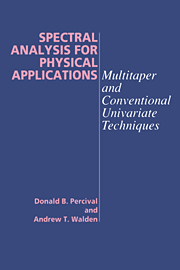Book contents
- Frontmatter
- Contents
- Preface
- Conventions and Notation
- Data and Software
- 1 Introduction to Spectral Analysis
- 2 Stationary Stochastic Processes
- 3 Deterministic Spectral Analysis
- 4 Foundations for Stochastic Spectral Analysis
- 5 Linear Time-Invariant Filters
- 6 Nonparametric Spectral Estimation
- 7 Multitaper Spectral Estimation
- 8 Calculation of Discrete Prolate Spheroidal Sequences
- 9 Parametric Spectral Estimation
- 10 Harmonic Analysis
- References
- Author Index
- Subject Index
Preface
Published online by Cambridge University Press: 04 December 2009
- Frontmatter
- Contents
- Preface
- Conventions and Notation
- Data and Software
- 1 Introduction to Spectral Analysis
- 2 Stationary Stochastic Processes
- 3 Deterministic Spectral Analysis
- 4 Foundations for Stochastic Spectral Analysis
- 5 Linear Time-Invariant Filters
- 6 Nonparametric Spectral Estimation
- 7 Multitaper Spectral Estimation
- 8 Calculation of Discrete Prolate Spheroidal Sequences
- 9 Parametric Spectral Estimation
- 10 Harmonic Analysis
- References
- Author Index
- Subject Index
Summary
All theory, my friend, is gray,
But green is the lustrous tree of life.
Mephistopheles, as quoted in Goethe's FaustIn many areas of the physical sciences, spectral analysis finds frequent and extensive use. Examples abound in oceanography, electrical engineering, geophysics, astronomy and hydrology. Spectral analysis is a well-established standard – its use in so many areas in fact facilitates the exchange of ideas across a broad array of scientific endeavors. As old and as well-established as it is, however, spectral analysis is still an area of active on-going research (indeed, one of the problems for both practitioners and theorists alike is that important methodological advances are spread out over many different disciplines and literally dozens of scientific journals). Since the 1960s, developments in spectral analysis have had to take into account three new factors:
Digital data explosion. The amount of data routinely collected in the form of time series is staggering by 1960s standards. Examples include exploration seismic data, continuous recordings of the earth's magnetic field, large seismology networks, real-time processing of sonar signals and remote sensing from satellites. The impact on spectral analysis is that fast and digital processing has become very important.
Enormous increase in computational power. In retrospect, it is clear that much of the spectral analysis methodology in vogue in the 1960s was influenced heavily by what could be calculated with commonly available computers. With the computational power now widely available on today's computers, we are finally in a position to concentrate on what should be calculated.
[…]
Information
- Type
- Chapter
- Information
- Spectral Analysis for Physical Applications , pp. xv - xviiiPublisher: Cambridge University PressPrint publication year: 1993
Accessibility standard: Unknown
Why this information is here
This section outlines the accessibility features of this content - including support for screen readers, full keyboard navigation and high-contrast display options. This may not be relevant for you.Accessibility Information
- 1
- Cited by
